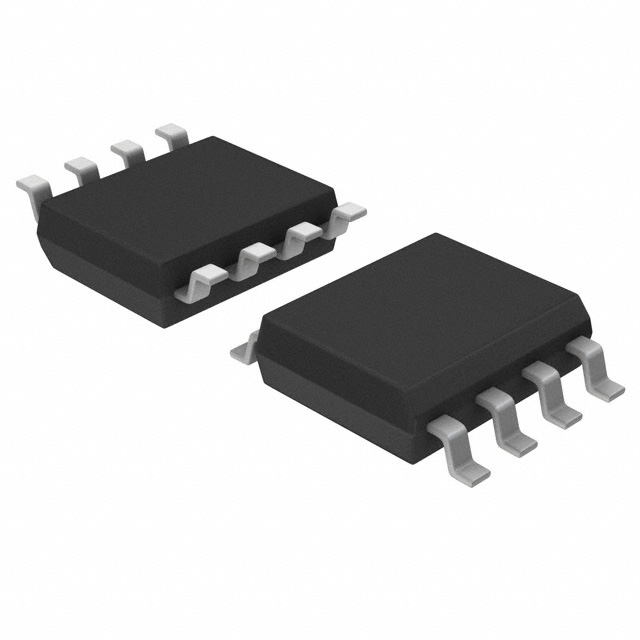Siehe Spezifikationen für Produktdetails.

LMC555CM/NOPB
Product Overview
Category: Integrated Circuit (IC)
Use: The LMC555CM/NOPB is a precision timer integrated circuit that can be used in various applications requiring accurate timing control. It is commonly used in electronic circuits for generating precise time delays, oscillations, and pulse width modulation.
Characteristics: - High accuracy and stability - Wide operating voltage range - Low power consumption - Compact package size - Easy to use and integrate into circuit designs
Package: The LMC555CM/NOPB is available in an 8-pin SOIC (Small Outline Integrated Circuit) package.
Essence: The LMC555CM/NOPB is based on the popular NE555 timer IC, offering improved performance and additional features.
Packaging/Quantity: The LMC555CM/NOPB is typically sold in reels or tubes containing multiple units, with each reel/tube containing a specific quantity of ICs.
Specifications
- Supply Voltage Range: 2V to 18V
- Operating Temperature Range: -40°C to +85°C
- Timing Capacitance Range: 100pF to 100μF
- Output Current: 200mA
- Trigger Voltage: 1/3 Vcc
- Threshold Voltage: 2/3 Vcc
- Maximum Power Dissipation: 600mW
Detailed Pin Configuration
The LMC555CM/NOPB has 8 pins arranged as follows:
- GND (Ground): Connected to the ground reference of the circuit.
- TRIG (Trigger): Used to initiate the timing cycle.
- OUT (Output): Provides the output signal according to the timing configuration.
- RESET (Reset): Resets the timing cycle when triggered.
- CTRL (Control): Provides external control over the timing characteristics.
- THRES (Threshold): Determines the threshold voltage for the timing cycle.
- DISCH (Discharge): Discharges the timing capacitor during the timing cycle.
- VCC (Supply Voltage): Connected to the positive supply voltage of the circuit.
Functional Features
- Accurate timing control with high precision and stability.
- Wide operating voltage range allows for flexibility in various applications.
- Low power consumption makes it suitable for battery-powered devices.
- Compact package size enables easy integration into circuit designs.
- Versatile functionality for generating time delays, oscillations, and pulse width modulation.
Advantages and Disadvantages
Advantages: - Improved performance compared to the NE555 timer IC. - Wide operating voltage range enhances versatility. - Low power consumption prolongs battery life. - Compact package size facilitates space-constrained designs.
Disadvantages: - Limited output current capability (200mA). - Requires external components for precise timing configuration.
Working Principles
The LMC555CM/NOPB operates based on the principles of an astable multivibrator or a monostable multivibrator, depending on the external component configuration. In the astable mode, the timing capacitor charges and discharges between two voltage thresholds, generating a continuous square wave output. In the monostable mode, a trigger initiates a timing cycle, producing a single pulse output with a duration determined by the external timing components.
Detailed Application Field Plans
The LMC555CM/NOPB finds extensive application in various electronic circuits, including but not limited to: 1. Timing circuits for controlling switches, relays, and motors. 2. Pulse width modulation (PWM) circuits for motor speed control and LED dimming. 3. Oscillator circuits for generating clock signals and frequency generation. 4. Precision timing circuits for accurate time delays and synchronization. 5. Timer circuits for sequential operations and time-based control systems.
Detailed and Complete Alternative Models
- NE555: The predecessor of the LMC555CM/NOPB, offering similar functionality but with slightly lower performance.
- TLC555: A CMOS version of the NE555, providing improved power efficiency and wider operating voltage range.
- ICM7555: A low-power version of the NE555, suitable for battery-powered applications.
- LM556: A dual timer IC that combines two independent timers in a single package, offering enhanced functionality.
These alternative models provide similar timing control capabilities and can be used as substitutes depending on specific requirements and availability.
Word count: 550 words
Listen Sie 10 häufige Fragen und Antworten im Zusammenhang mit der Anwendung von LMC555CM/NOPB in technischen Lösungen auf
What is the maximum operating frequency of LMC555CM/NOPB?
- The maximum operating frequency of LMC555CM/NOPB is typically 2.7 MHz.Can LMC555CM/NOPB be used in low-power applications?
- Yes, LMC555CM/NOPB is suitable for low-power applications due to its low power consumption.What is the voltage range for LMC555CM/NOPB?
- LMC555CM/NOPB operates within a voltage range of 4.5V to 15V.Is LMC555CM/NOPB suitable for precision timing applications?
- Yes, LMC555CM/NOPB can be used in precision timing applications with proper design considerations.Can LMC555CM/NOPB be used as a monostable multivibrator?
- Yes, LMC555CM/NOPB can function as a monostable multivibrator with appropriate circuit configuration.What are the typical output drive capabilities of LMC555CM/NOPB?
- LMC555CM/NOPB has a typical output drive capability of 200mA.Is LMC555CM/NOPB compatible with both CMOS and TTL logic levels?
- Yes, LMC555CM/NOPB is compatible with both CMOS and TTL logic levels.Can LMC555CM/NOPB operate in astable mode?
- Yes, LMC555CM/NOPB can operate in astable mode to generate square wave signals.What is the temperature range for LMC555CM/NOPB?
- LMC555CM/NOPB is designed to operate within a temperature range of -40°C to 125°C.Are there any specific layout considerations for using LMC555CM/NOPB in PCB designs?
- It is recommended to follow the layout guidelines provided in the datasheet to ensure proper performance of LMC555CM/NOPB in PCB designs.

